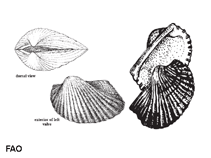Anadara notabilis (Roding, 1798)
Eared arkWarning: DOMDocument::load(): SSL operation failed with code 1. OpenSSL Error messages: error:140770FC:SSL routines:SSL23_GET_SERVER_HELLO:unknown protocol in C:\Apache24\htdocs\includes\SpeciesSummary.lib.php on line 1236
Warning: DOMDocument::load(): Failed to enable crypto in C:\Apache24\htdocs\includes\SpeciesSummary.lib.php on line 1236
Warning: DOMDocument::load(https://sealifebase.nrm.se/webservice/AquaMaps/getAMap.php?genus=Anadara&species=notabilis): failed to open stream: operation failed in C:\Apache24\htdocs\includes\SpeciesSummary.lib.php on line 1236
Warning: DOMDocument::load(): I/O warning : failed to load external entity "https://sealifebase.nrm.se/webservice/AquaMaps/getAMap.php?genus=Anadara&species=notabilis" in C:\Apache24\htdocs\includes\SpeciesSummary.lib.php on line 1236
Classification / Names Common names | Synonyms | CoL | ITIS | WoRMS
| Arcida | Arcidae
Environment: milieu / climate zone / depth range / distribution range Ecologia
; intervalo de profundidade 0 - 75 m (Ref. 104365). Tropical; 70°N - 34°S, 98°W - 34°W
Distribuição Países | Áreas FAO | Ecossistemas | Ocorrências | Introduções
Western Atlantic. Tropical to polar climates of northern hemisphere.
Length at first maturity / Tamanho / Peso / Idade
Maturity: Lm ? range ? - ? cmCommon length : 9.0 cm TL macho/indeterminado; (Ref. 344)
Descrição suscinta Morfologia
Shell heavy, sturdy, inequivalve, with one valve slightly larger than the other. Anterior end short and rounded, posterior end longer and angled. Hinge straight. Sculpture of 25 to 27 radial ribs crossed by fine concentric lines prominent between ribs. Ribs never bifurcated. Umbones prominent, ligamental area large, hinge long, straight. Periostracum heavy. Colour: white; periostracum brown. It is consumed locally in soups amd chowders (Ref. 271).
Assumed total length is 9 cm (Ref. 344). Epibiotic (Ref. 104365). Found in soft bottoms (mud or sand), sometimes on seagrass environment at shallow intertidal depths (Ref. 271). Commensal with amphipods (Ref. 82302).
Life cycle and mating behavior Maturidade | Reprodução | Desova | Ovos | Fecundidade | Larvas
Members of the class Bivalvia are mostly gonochoric, some are protandric hermaphrodites. Life cycle: Embryos develop into free-swimming trocophore larvae, succeeded by the bivalve veliger, resembling a miniature clam.
Referência principal
Referências | Coordenador | Colaboradores
Leal, J.H. 2003. (Ref. 344)
Status na Lista Vermelha da IUCN (Ref. 130435)
Status no CITES (Ref. 108899)
Not Evaluated
CMS (Ref. 116361)
Not Evaluated
Perigo para os humanos
Uso pelos humanos
| FishSource |
Ferramentas
Mais informação
Fontes da internet
BHL | BOLD Systems | CISTI | DiscoverLife | FAO(Publication : search) | Fishipedia | GenBank (genoma, nucleotídeo) | GloBI | Gomexsi | Google Books | Google Scholar | Google | PubMed | Árvore da vida | Wikipedia (Ir para, procura) | Registro zoológico
Estimates based on models
Preferred temperature
(Ref. 115969): 22.9 - 28, mean 26.1 (based on 372 cells).



